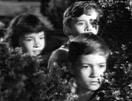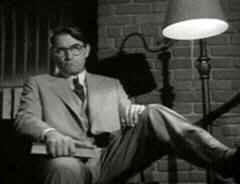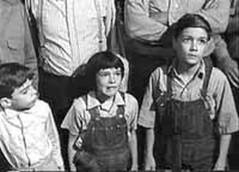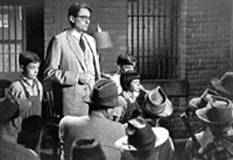TO KILL A MOCKINGBIRD: SEEING THE FILM THROUGH THE LENS OF MEDIA LITERACY
© 2006 Frank Baker
download this page as an Adobe (pdf) document
SCENE ANALYSIS
In order for students to effectively study or analyze a scene from the film, they will need some guidance and practice. Be sure to review the LANGUAGE OF FILM and CAMERA SHOTS in this guide. In analyzing a scene, it is important to watch it more than once. Different students might be assigned to be on the lookout for different elements. Those elements might include: camera angles, camera movement, music, sound effects, lighting, wardrobe, setting, expressions, etc.
Confrontation at the jail DVD Chapter 21 The Lynch Mob 1:01:33
    |
The scene begins with Jem, Scout
and Dill in the bushes, looking from a distance, at their father who sits alone outside the jail the night before the trial is to begin. Atticus expects trouble, and sure enough a number of cars pull up and men with guns get out. The men, one of whom is Walter Cunningham, intend to lynch Tom Robinson. (Notice how calm Atticus is in the face of the threats.) The children quickly make their way to the front of the mob. Atticus, surprised to see them, tells them to go home, but Jem refuses. A brief scuffle ensues, after which the children move from the crowd It’s at that moment that Scout recognizes Mr. Cunningham and engages in a polite conversation which quickly defuses the incident. |
Analysis of this Scene:
There is an establishing shot in the dead of night in which Atticus reads a book under a lamp. Here Atticus sits surrounded by darkness and engulfed by the lone light of his lamp. It gives a metaphoric impression that he is a man protecting the light of truth in a dark and hostile environment. Many of the camera angles used for Atticus are low angle shots. This fact seems important for two reasons. First, we see Atticus the same way the children would seem him. In other words we are forced to look up at him in the same way Scout of Jem would. Second, the angle enhances the sense of stability we feel from Atticus and helps support the fundamental strength of his ideas.1



